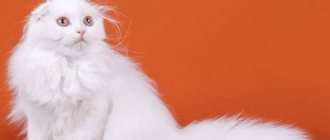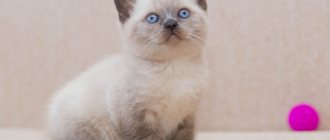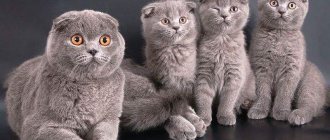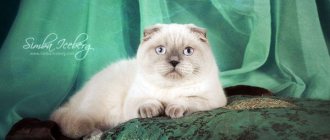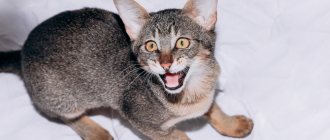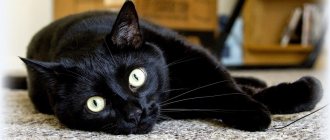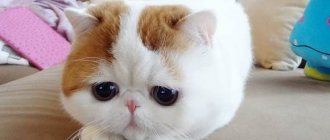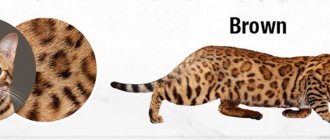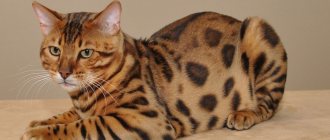Animal selection requires mandatory documentary confirmation. For ease of classification, felinology has adopted codes (encodings) for cat breeds and colors. Coding has general principles and indices.
The breed is designated by three capital English
letters.
The main color is in lowercase English letters
. Color group, eye color, ear shape, tail shape - in pairs of numbers. The encoding must be included in the documents on the breeding origin of the animal (pedigree, metrics). The order of numbers may differ in different felinological systems.
XXX xx NN NN NN (NN)
XXX
– breed code;
xx
– coding of the main color;
NN
– digital designation of color, eye color, ear shape, etc.
In the IFA system, the arrangement of numbers in a color is accepted according to its name, for example, the color “black silver marbled bicolor with yellow eyes” - ns 22 03 62
(
n
– black,
s
– silver,
22
– marbled,
03
– bicolor,
62
– orange/yellow eye color).
Numerical designation of colors (NN – in general coding)
- The number 0 begins to indicate the presence of white in color
- The number 1 begins to indicate the degree of tipping
- The designation of the design variant begins with the number 2
- The number 3 begins to indicate the point color variant
- The number 5 begins to indicate the length of the tail (not always indicated)
- The number 6 begins to indicate eye color (not always indicated)
- The number 7 begins to indicate the shape of the ears.
| White quantity coding (bicolor scheme) |
| 01 – harlequin |
| 02 – harlequin |
| 03 – bicolor |
| 09 – nonspecific white spots (“medallion”, “socks”) |
| Tipped color coding |
| 11 – closed |
| 22 – veiled (chinchilla, cameo) |
| Tabby pattern encoding |
| 21 – indeterminate tabby (for sphinxes, vans, harlequins, color-points) |
| 22 – marble |
| 23 – striped |
| 24 – spotted |
| 25 – ticked |
| Color point color coding |
| 31 – Burmese pointing |
| 32 – Tonkinese pointing |
| 33 – Siamese pointing |
| Tail length coding |
| 51 – tailless (only for the Manx breed) |
| 52 – short tail (for the bobtail breed) |
| 53 – pushed back bob |
| 54 – normal tail length |
| Eye color coding |
| 61 – blue eyes |
| 62 – orange eyes |
| 63 – differently colored eyes (necessarily one blue) |
| 64 – green eyes |
| 65 – Burmese eye color |
| 66 – Tonkinese eye color |
| 67 – Siamese eye color |
| Ear shape coding |
| 71 – straight |
| 72 – ears curled back (curl) |
| 73 – ears folded forward (fold) |
Abbreviated breed names
| ABY | Abyssinian |
| BAL | Balinese |
| BOM | Bombay |
| BRI | British |
| BUL | burmilla |
| BUR | Burmese |
| CHA | Chartreux |
| CIM | Kymrik |
| CRX | Cornish Rex |
| DRX | Devon Rex |
| DSX | Don Sphynx |
| EUR | European KSH (shorthair) |
| EXO | exotic KS |
| GRX | german rex |
| JAV | Javanesian |
| J.B.T. | Japanese Bobtail |
| KBL | Kurilian Bobtail DSh (longhair) |
| KBS | Kurilian Bobtail KSh |
| KOR | korat |
| MAN | Manx |
| MAU | Egyptian Mau |
| MCO | Maine Coon |
| MUN | munchkin |
| NFO | Norwegian Forest |
| NEV | Neva Masquerade |
| ORI | oriental |
| PTB | Peterbald |
| PER | Persian |
| PET | domestic cat |
| RAG | ragdoll |
| RUS | Russian blue |
| SBI | sacred burma |
| SCS | Scottish KS |
| SCL | Scottish DS |
| SFL | Scottish fold DS |
| SFS | Scottish fold KSh |
| SIA | Siamese |
| SIB | Siberian |
| SIN | Singapore |
| SNO | snow shoo |
| SOM | Somalia |
| SPH | Canadian Sphynx |
| TUA | angora |
| TUV | turkish van |
Tabby
The most common group of Scottish coat colors, which is further divided into subcategories:
- shaded - marble coloring;
- mackerel - tiger coloring;
- spotted - spotted coloring.
As for color variations, the tabby is represented by the following:
- silver (black pattern on a cold steel background);
- cameo (bright carrot stripes on a white background);
- silver-blue (gray pattern on a cold steel background);
- cream (dark beige pattern on a delicate cream background);
- red (bright red pattern on a warm peach background);
- blue (rich gray pattern on a silver-beige background);
- cinnamon (black design on a copper background).
Photos of Scottish tabby cats:
spotted tabby
A color in which there are separate spots on the body, ideally clear and not merging, uniform on the sides and back. It is formed with the help of the main Tabby genes and a complex of polygenes that “tear” the pattern into separate spots. Spotted and striped colors often form multiple transitional forms, and all these options are always classified as spotted color, because the stripes tend to “tear” as the animal grows older. Therefore, spotted is the most common color among the British patterned. Marble color is less susceptible to the action of “tearing” polygenes, because this is a wider and denser pattern, so only marble that is completely torn into spots is classified as a stain, while marble that has only been slightly exposed to polygenes will look like marble. In any case, the spotted pattern clearly shows which color was used to form the spot.
| Diagram showing how brindle and merle colors are transformed into spotted colors by polygenes. |
| Various modifications of spotted color | |
| small dots based on ticked color | round polka dots based on brindle color |
| loose large stains based on marble | rosette spots based on marble |
| Modifications of marble pattern (classic and bordered) |
This is true for all patterned colors - they value the correctness and clarity of the pattern. And also, according to the standard, a patterned animal must have a warm undercoat tone, which can vary from light sand to rich beige.
| Quite a contrasting pattern. At the same time, we see an intermediate option between brindle and spotted - dotted stripes along the ridge, the spots are not located in a checkerboard pattern, but in the form of vertical broken stripes, partially turning into spots. |
| Low-contrast blurry, too light pattern, fuzzy spots, blending into the background. Often, such a pattern is obtained as a result of mating with shaded ones, it is like an intermediate option between a chinchilla and a silver tabby, I call it a “hedgehog”. |
| Table showing possible problems with the patterned color using black silver marbled pattern (BRI ns 22) as an example. | ||
| Correct clear pattern, contrasting to the light background | The pattern is tipped like the Russian Blue breed (the hairs at the end have light tips), so it looks as if it was sprinkled with powder | Veil-like, light, not deeply colored, tipped pattern. Intermediate between chinchilla and silver tabby |
Tortoiseshells
The English name for the color is torti. On the fur of the “turtles” dark spots are intricately combined with light ones. The variegated coloring must be distributed evenly over the body, which distinguishes torties from tricolor cats.
In Scottish Folds, the “tortoise” pattern occurs in variations:
- black-red;
- creamy lilac;
- chocolate red;
- creamy blue.
Interestingly, only cats can be “turtles”. In cats, this is a genetic mutation indicating infertility.
Scottish fold tortie color:
Smoky
Other names for the color are smokey and smoky. This is the so-called typing color: the base of the hair is light, almost white, and the tip is dark.
Among the Scots, smokey is classified as silver. The color does not allow patterns on the coat - brindle, spotted, tortoiseshell. It is easy to distinguish a smoky color from a solid color - you need to part the fur. In a smoky, it is ⅔ colored - the base of the hairs is always light.
The main variations of “smoke”:
Photos of smoky Scottish folds:
Important rules for knitting by color
When mating, it is important to consider not only the name of the color, but also its quality. Thus, when mating black cats with blue and lilac cats, too light colors are dangerous because they will lighten the undercoat of black kittens.
High-quality light blue colors are obtained in lines where all parents are blue without admixtures of other colors.
Individuals of chocolate and lilac colors, tabbies in warm and golden tones are undesirable for mating with black and silver colors, because they will give birth to cubs with shades of red.
Crossing two white cats with dominant WW genes is fraught with the birth of deaf white kittens. But if both parents are heterozygous (white color Ww), then half of the offspring will be born white, and half will have a different color. In this case, deafness may be avoided. Although it is better not to breed two white parents at all.
It is also undesirable to breed cats of silver color with cats of solid color (blue, black, etc.), because the coat color will deteriorate.
Colorpoints are not mixed with bicolors and tabbies.
Chocolate and lilac colors go well together, and they can also be mixed with red and cream partners without patterns or ticking. For chocolate and lilac tabbies, golden cats with a pattern are also suitable.
If you cross two lilac parents, all the kittens will be lilac, but their coat quality will be reduced: the coat color will shift towards gray, and the eye color will be less expressive. It is better to choose a blue (purple carrier) or black partner.
When breeding color points, it is better to limit breeding to only these colors, that is, the nursery should work exclusively on color points when breeding high-quality point offspring. Otherwise, the point color will be darkened or will have a residual tabby pattern, as a result of which it will not be so beautiful. In addition, an unsightly yellowish tint may appear in cold point coats.
When mating a partner of a solid color with bicolors (tricolors), you can get a litter consisting of 50% kittens of solid colors, and 50% of bicolors (tricolors). When mating two bicolors or a bicolor and a tricolor, you can get a litter that will consist of 50% bicolors (tricolors), 25% harlequins, 25% kittens of solid colors.
A little about genetics
It is especially interesting how the color of a Scottish kitten is formed and what it depends on. In the genome of this breed, two colors predominate, responsible for the color of the animal - red and black. Anyone can, under certain conditions beyond a person’s control, become dominant. Such a gene suppresses weak ones, which are called recessive. There is also a third gene, the so-called diluent. It is responsible for the degree of pigmentation saturation.
When these genes are combined with each other, the most unusual coat colors of an animal can appear. It is extremely difficult to determine in the first weeks what color a kitten will have in the future. The shade he was born with is not constant and may change as he grows older. In some cases, dramatic changes occur. The change in shade begins at six months and lasts up to two years. The table below shows options for crossing the colors of parents, according to which their offspring inherits the coat color.
How the coat colors of the offspring are crossed.
Colors
| a | blue, blue point (a 33) |
| b | chocolate, choclit point (b 33) |
| c | lilac, lilac point (c 33) |
| d | red, red point (d 33) |
| e | cream, cream point (e 33) |
| f | black tortoiseshell, tortie point (f 33) |
| g | blue-cream, blue cake point (g 33) |
| h | chocolate tortoiseshell, choclit torty point (h 33) |
| j | lilac tortoiseshell, lilac tortie point (j 33) |
| n | black, seal point (n 33), ebony (for orientals) |
| o | sorrel, cinnamon |
| p | beige background |
| q | tortoiseshell sorrel |
| r | tortoiseshell, beige background |
| s | smoky, silver |
| w | white |
| y | gold |
| x | unrecognized color |
It is important!
It is not advisable to engage in breeding without the appropriate knowledge. The average person does not know what a hook on the tail looks like, how to recognize early dysplasia (which cannot be treated, the animal is disabled for life), undershots, undershots, polydactyly and much more, which makes cats unsuitable for breeding. Especially if it is a Scottish breed (Scots are prone to genetic problems of the musculoskeletal system - MURCOTICS). To do this, we need breeding assessment sheets from an expert from exhibitions to eliminate disqualifying factors for further breeding. You need permission from the club in which the breeding animals must belong. Documents are required for all animals. After all, if there are no documents, then there is no breed, and there are plenty of outbred or phenotypic (only outwardly similar to Scots - MURKOTICS) on the streets and in shelters.
Source
Ticked
The ticked color differs from the tipped color in that the hair is colored not in two, but in three different shades:
- white on base;
- colored along the length of the hair;
- black at the tip.
Today, the ticked color is the rarest among the Scottish. Due to its lack of prevalence and amazing beauty, its bearers are much more expensive than “Scots” of other colors.
Photos of ticked Scottish folds:
Quite an interesting coloring of Scotch cats: the cat is white, and there are colored spots on its face and tail. Several colored inclusions on the body and paws are allowed. The color of the spots can be not only monochromatic, but also tabby - marbled, striped.
Photos of Van color owners:
Harlequin
The name was given because the owner of the color is similar to a harlequin. The main color of the coat is white. And only ⅕-⅙ of the body area are colored spots. They are not concentrated in one area, but can be scattered throughout the body.
Photos of harlequin cats:
Shaded
Shedded (shaded color) is the third variation of typing colors. These cats have ⅔ white hair and ⅓ colored hair. Tipped fur does not cover the entire body, but only the back, sides, back of the head, neck, and tail. White coat - on the belly, chin, and lower part of the tail.
Shedded is represented by coloring pages:
Photo of “Scots” of shaded color:
Bicolors
The bicolor tartan will be painted in two colors. The first one is necessarily white. The second one can be cream, tabby, black, red, blue. Breed standards require that the double coloring be symmetrical.
Photo of “Scots” bicolor:
Chinchilla
Another variation of the tipped color: only a certain part of the hair is colored, and the base is white. If smoky cats have ⅔ colored hairs, then chinchillas have only ⅛ colored hairs. Because of such an unusual coloring, it seems that the white Scottish Fold has an unusual color coating. The chinchilla color comes in variations:
- golden;
- silver;
- blue golden.
The last type is the rarest, which is why its owners are the most expensive.
"Scots" chinchilla colors:
Plain or solid
A solid color means that there is no additional color either as a base tone or as an undertone. Occasionally, single-colored Scots may have streaks or spots on the face, but the quality of the coat in this case is sharply reduced. In another way, solid colors are called solid, and they come in the following types:
- snow-white. The fur of such cats is perfectly white, the nose is pink, and the eyes are amber or golden;
- black Scottish cats have paw pads and nose that match the color of their coat;
- gray or blue. The eyes of Scots of this color are amber, and the pads of their paws are a covering shade;
- lilac is a mixture of light gray and warm cream;
- a red fold-eared kitten can also be called red, and have a nose and paws of a similar shade;
- Cinnamon kittens resemble saffron milk caps, but their fur is darker in color, similar in shade to rust or the famous spice cinnamon.
Solid colored cats have a number of advantages and disadvantages. As for the advantages, the solid deep color is very much appreciated among show kittens. Moreover, this color is easier to control at the mating stage - it will be easier for you to predict what result you will get.
Color classification
A classification has been developed that divides the colors of animals of this breed into the following groups:
- solid;
- bicolor;
- tortoiseshells;
- tabby;
- tipped;
- color point, etc.
Solid colors
This group includes cases when the animal’s fur is uniformly colored with one rich color.
The main solid colors are:
White wool indicates the absence of the gene responsible for color. Pure white cats, as well as albinos, are extremely rare. At birth, they may have blue or black spots for a short period, which later disappear.
The eyes of Scottish cats with white fur may have a gray or amber tint. There are individuals with irises of different colors.
The Scottish Fold Lilac was recently developed and is considered rare. This group includes animals with light fur with a pinkish, deer, or lilac tint. Changes in color intensity are undesirable.
Scottish Fold solid color.
Solid black cats are rare. The presence of brown and red spots, as well as a grayish tint, is not allowed. Fold-eared and straight-eared cats often have a blue coat color. This category includes animals whose fur has a light gray tint. Some kittens have a pattern, but it disappears when they shed.
Scottish red cats are extremely rare. Such animals are distinguished by solid fiery red fur. The earlobe and pads are red. A faded pattern is allowed on the paws, forehead and tail.
Cream coloring is common among Scots. The animals have a reddish coat and a peach-colored undercoat. A vague pattern on the head in the forehead area is allowed, but the presence of leopard markings is unacceptable.
The Scottish Fold chocolate is rare. The shade cinnamon is especially rare. Brown fold kittens should have uniform fur color.
Patterned
Any color can be patterned.
The shape of the pattern is determined by a series of T (tabby) genes. And such genes are present in the genotype of absolutely every cat. But, as you know, not every cat is striped or spotted. It's all about another gene - A (agouti). This gene either “turns on” or “turns off” as the hair grows, coloring the hairs in transverse rings with alternating dark and light tones. Decoding the colors of cats begins with a search for two genes in the genotype - T and A. If there is at least one A, the cat will be patterned. If there are two aa in the genotype (homozygous recessive set), the fur coat will be colored evenly, since without ticking (coloring the fur in stripes) a pattern is impossible. So, what does the color of a tabby cat mean? The answer is obvious: the cat is a carrier of the dominant agouti gene (A). Now let's look at the tabby gene (T):
Ta (Abyssinian) is dominant to T (stripes), and T is dominant to Tb (marble). But there are still spots! But with them it’s more complicated: either there is a specific gene that allows spotting to appear, or the spots are the result of the work of a group of modifier genes that “break” the stripes (the latter is more likely).
Solid
This coat coloring is also called plain, solid. The main feature is that the coat is uniformly colored in one color, without even the slightest inclusions of a different tone. The color is equally saturated along the entire length of the hair.
Solid suits of the “Scots”:
- blue (gray-silver);
- ebony (all black);
- red (red);
- white;
- cream;
- chocolate (rich brown color);
- cinnamon (cinnamon tones);
- lilac (beige with a lilac, pinkish tint);
- “fauns” (beige, piebald).
The most classic color for Scottish cats is blue.
Photos of Scottish cats of solid colors:
Varieties of Scottish cats
There are 2 main varieties of Scottish cats. The first category includes Scottish Straight animals. Their feature is small erect ears. The second group includes Scottish Fold animals, which, as a result of a natural mutation, have an abnormal structure of the ear cartilage: it cannot be in an upright position.
Both varieties are distinguished by a massive, stocky body, large head and dense fur with a thick undercoat.
For a long time, the smoky and peach shade of fur in cats of this breed prevailed. This was due to the fact that there was no breeding base and individuals often had admixtures of British cat blood. Nowadays there are one-color, two-color, and three-color animals. The color depends on the predominance of genes in the cat. When evaluating an animal, color saturation is taken into account.
